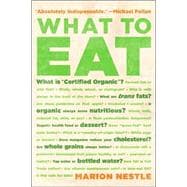
Note: Supplemental materials are not guaranteed with Rental or Used book purchases.
Purchase Benefits
What is included with this book?
| Introduction | p. 3 |
| The Supermarket: Prime Real Estate | p. 17 |
| The Produce Section | |
| Fruits and Vegetables: The Price of Fresh | p. 25 |
| Organics: Hype or Hope | p. 37 |
| Produce: Safe at Any Price | p. 46 |
| Genetically Modified, Irradiated, and Politicized | p. 56 |
| The Dairy Section | |
| Milk and More Milk | p. 67 |
| Milk: Subject to Debate | p. 80 |
| Dairy Foods: The Raw and the Cooked | p. 91 |
| Yogurt: Health Food or Dessert | p. 99 |
| The Dairy Substitutes | |
| Margarine: Accept No Substitutes | p. 108 |
| Margarine: You Can Believe It's Not Butter | p. 118 |
| Soy Milk: Panacea, or Just Another Food | p. 127 |
| The Meat Section | |
| A Range of Meaty Issues | p. 138 |
| Meat: Questions of Safety | p. 151 |
| Meat: Organic Versus "Natural" | p. 165 |
| The Fish Counter | |
| Fish: Dilemmas and Quandaries | p. 181 |
| Fish: The Methylmercury Dilemma | p. 190 |
| The Fish-Farming Dilemma | p. 203 |
| The Fish-Labeling Quandaries | p. 218 |
| More Seafood Dilemmas: Safety and Sustainability | p. 234 |
| The Center Aisles: Cool and Frozen | |
| Eggs: The "Incredible" Edibles | p. 248 |
| Eggs and the Salmonella Problem | p. 264 |
| Frozen Foods: Decoding Ingredient Lists | p. 274 |
| A Digression into Calories and Diets | p. 282 |
| Frozen Foods: Reading Nutrition Facts | p. 296 |
| The Center Aisles: Processed | |
| Processed Foods: Wheat Flour and the Glycemic Index | p. 305 |
| Sugar(s) | p. 317 |
| Cereals: Sweet and Supposedly Healthy | p. 335 |
| Packaged Foods: Health Endorsements | p. 350 |
| Snack Foods: Sweet, Salty, and Caloric | p. 357 |
| Foods Just for Kids | p. 370 |
| Oils: Fat and More Fat | p. 385 |
| The Beverage Aisles | |
| Water, Water Everywhere: Bottled and Not | p. 401 |
| "Healthy" Drinks: Sugared and Artificially Sweetened | p. 416 |
| Teas and Coffees: Caffeine to Eco-Labels | p. 435 |
| The Special Sections | |
| Infant Formula and Baby Food | p. 451 |
| Supplements and Health Food | p. 466 |
| Bread: The Bakery | p. 481 |
| Prepared Foods: Salads and More | p. 497 |
| Conclusion: Taking Action | p. 510 |
| Food Measures: Conversion Factors | p. 527 |
| Terms Used to Describe Fats and Oils in Foods | p. 529 |
| Notes | p. 533 |
| Acknowledgments | p. 589 |
| Index | p. 591 |
| Table of Contents provided by Ingram. All Rights Reserved. |
The New copy of this book will include any supplemental materials advertised. Please check the title of the book to determine if it should include any access cards, study guides, lab manuals, CDs, etc.
The Used, Rental and eBook copies of this book are not guaranteed to include any supplemental materials. Typically, only the book itself is included. This is true even if the title states it includes any access cards, study guides, lab manuals, CDs, etc.